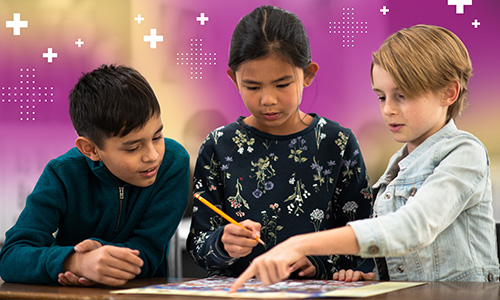
As the summer truly transitions to fall—even though we’re still awaiting permission to don our sweaters here in the Pacific Northwest, and my family in Georgia confirms—all of us have headed back to school and are settling into the groove of the new year. In my sixth-grade math class, I’m meeting my students and uncovering what they have and haven’t seen, processed, or remembered from their previous math classes.
This kind of “uncovering” happens in many ways: class participation, diagnostic tests, and students’ self-reporting. I’m using all my tricks to understand each student’s mathematical ecosystem. What seems shaky? What seems solid?
Sometimes forgotten in the math classroom is the power of conversation. I sat down with Anita Brown, a math content designer at NWEA®, to talk about talking about math. Anita holds a BS in mathematics from the University of Illinois at Urbana-Champaign, and before getting her teaching license, she spent time as a computer programmer. You could say her passion is math instruction as a social justice act.
I wanted to dig deeper with her about how formative conversations—ungraded, structured, facilitated chats meant to inform next steps in teaching and learning—specifically uphold the pursuit of equity in the classroom. I walked away with four light bulb moments about these conversations, how they shape our classrooms, and what they might look like in actual practice.
Wait, remind me what formative conversations in math are?
In Anita’s words, formative conversations in math are “conversations you have with kids to get inside their brains, hear what they’re thinking about math, and make them think critically in ways they may not have done before.”
She adds, “If you craft that just-right question and give kids that opportunity, it may spark the idea that connects to something they’ve heard before that eventually creates that web that we want them to create. To understand that math is really just a bunch of connected concepts.”
Formative conversations in math are all about getting students to be creative and curious rather than compliant.
Light bulb moment #1: Formative conversations aren’t a “soft skill” or a “nice-to-have”; they’re essential in the pursuit of equity
Formative conversations are a mic-sharing moment. The more we let students talk, the more equity we are handing them.
Besides the fact that they don’t always have to be aloud (spoiler alert for #2 below), Anita clarifies that the equity lies in the opportunity for all students to be exposed—even if their participation within the conversation looks different—to high-quality, rigorous instruction.
Keep this in mind: as we talk about math, it’s impossible to talk about isolated concepts. Imagine trying to discuss a square root without talking about exponents or squares or multiplication. Mathematics is a giant interconnected web of ideas, which we, as teachers, attempt to articulate over a student’s K–12 experience. As we have these conversations, all students get stuck—but in a good way—in that web.
Sometimes forgotten in the math classroom is the power of conversation.
Even as we have small group instruction, intervention, and differentiation, formative conversations bring us all back to the round table, as equals, ready to be curious rather than correct.
We have students with different strengths and needs in our classroom, and it’s essential that we ensure everyone’s access to grade-level curricula. Differentiation within formative conversations occurs in their scaffolding, putting supports in place: Turn and talk. Pause and journal. Invite a student to summarize what another student said.
In the individual sense, formative conversations are an intimate look inside a given student’s brain, and more equity mileage is gained in the subsequent instructional follow-up that you’re able to conduct as the teacher. When you catch that a student is really struggling to connect that 4 is read as four squared which is 4×4, you know to follow up with that student and draw a grid of four up and four across—revealing a square.
Mute yourself for a minute. Pass the mic to your students. Equity is about uplifting those whose voices are seldom heard.
Light bulb moment #2: Formative conversations don’t have to be aloud
When I first learned about formative conversations (in their formal sense of a planned, facilitated discussion with conversation starters), I immediately grew anxious on behalf of my quieter students. I had a hard time picturing equity when all I could imagine were my introverts! Speaking aloud about math does require a certain bravery, self-assuredness, and mathematical self-perception. And so, when people say that conversations are an equitable tool, sometimes my teacher brain is like, how?
Anita emphasizes that formative conversations don’t have to be traditional, Socratic, or “fishbowl” discussions, but can be reimagined for the digital, asynchronous age. “Speech isn’t the only way we can have a conversation. It’s just one way! Inclusivity and equity ask us to broaden our ideas, our concepts, of what it means to have a conversation.”
Invite (or require!) students to share their ideas later. Perhaps they comment on a Google Doc or Jamboard; they comment on your online class platform; they leave a multimedia response on a class Padlet; or they record a minute-long video response in Flipgrid (now called Flip).
It doesn’t even have to be digital! Consider the old-school comment box, a Post-it wall, or even a small-group follow-up discussion in your room at lunch. Remember: you’re inviting students to talk to you, however they want to.
Light bulb moment #3: Formative conversations can be five minutes long (and melodrama is your friend)
Teachers deserve equitable practices, too. That means that baby steps like smaller conversations with smaller groups of students may be where teachers can start. In fact, it may be where you already are! Think about it: the “ingredients” of a formative conversation are:
- A set of questions meant to stimulate conversation around a particular cluster of math skills (“What is a fraction?” “What is the relationship between that top number—what’s it called?—and that bottom number?” “Oh, I noticed you just said ‘4/8 is basically one half.’ What do you mean?”)
- The teacher talking less than the students
- The teacher not correcting or “saving” the students
- The teacher gathering information about student thinking to apply to future instruction
Chances are, you’re probably doing at least two of the four above (that’s one half, if you’re following), and they don’t always require more than a few minutes.
Anita shares a time-honored teacher trick to add value to these short bits of time: melodramatic acting and spur-of-the-moment ideas. “Act excited! Sneak in an introductory formative conversation starter by sharing something they’ll think is tangential,” she says. “For instance, I said recently, ‘You know what I heard on a podcast? Neil DeGrasse Tyson said that you could figure out the age of the Earth and when disasters will happen just by using ratios. Gasp! What do you think he meant? Also: What are ratios, again?’ I followed this with the ‘sudden idea’ to have students listen to the podcast so we could talk about it more together.”
Our Oscar nominations should be announced any day now.
Light bulb moment #4: Formative conversations have staying power outside of the classroom
Formative conversations set a tone of exploration, curiosity, and community. And our students carry these values with them when their class with us ends.
“This is all about the thinking and not about the answer,” Anita says. “It’s about cultivating a classroom environment where kids feel safe to make mistakes. We are building not just their mathematics identity, but their sense of belonging in your classroom. And that leads to a sense of belonging in the entire school community.”
Formative conversations [are] ungraded, structured, facilitated chats meant to inform next steps in teaching and learning.
The best news? Formative conversations teach us to be better listeners and better humans: “The communication strategies that you’re learning—how to elicit evidence from kids all the time—leads you to become a better listener and communicator in your entire life,” Anita explains.
The more we talk about math, the more students are able to realize that the focus isn’t the right answer. This kind of bravery can lead to mistake-rich and curiosity-driven conversations in other classes: Music and Spanish. Lunch and lab. When the bell rings, the magic lasts.
The secret sauce? Your own vulnerability
I ended my talk with Anita by asking her what composes the “secret sauce,” the “X factor,” of hosting a good formative conversation. How can teachers, seasoned and new, embark on this journey with confidence, nuance, and patience?
“Be vulnerable yourself,” she says. “Students need to see you accepting mistakes. If you treat formative conversations as a wonderful practice full of low-stakes exploration, then that’s how your kids will see them, too.”
Emphasize to students that there are no grades, no points, no right or wrong. Formative conversations are an opportunity to be as creative as possible.







